MARIANI’S
Virtual
Gourmet
November 11,
2018
NEWSLETTER
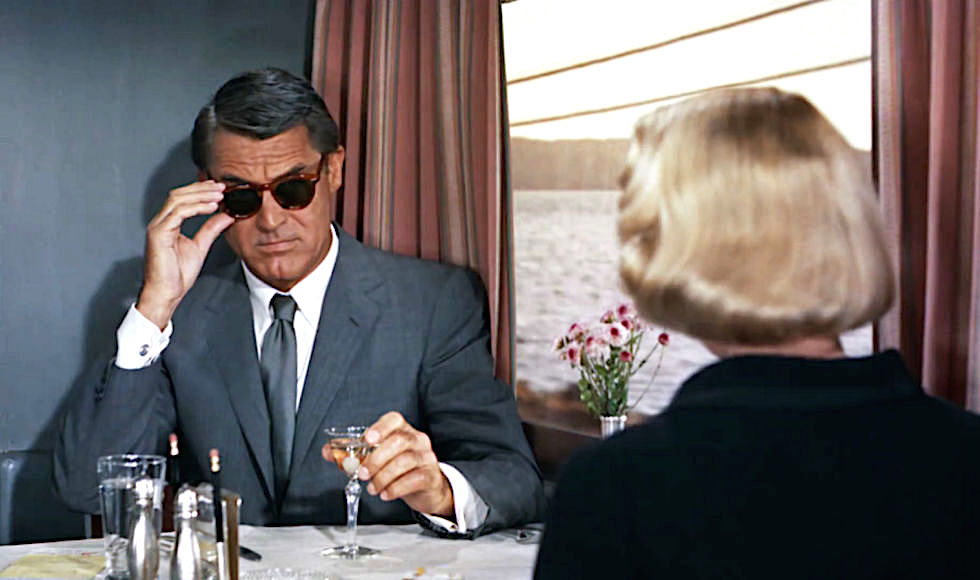
❖❖❖
IN THIS ISSUE
ST. LOUIS, MO
Part One
By John Mariani
NEW YORK CORNER
LEGASEA
By John Mariani
NOTES FROM THE WINE CELLAR
WHAT I'M DRINKING NOW
By John Mariani
❖❖❖
ST. LOUIS, MO,
REBOUNDS BY UPDATING ITS
HISTORY AND CULTURE
Part One
By John Mariani

Don’t for a moment
think that the city fathers of St. Louis weren’t
thinking of Paris’s Arc de Triomphe, Berlin’s
Brandenburg Gate, New York’s Statue of Liberty
or San Francisco’s Golden Gate Bridge when they
put up their 630-foot-tall Gateway Arch. If
iconic is an over-used word these days, none
better applies to the 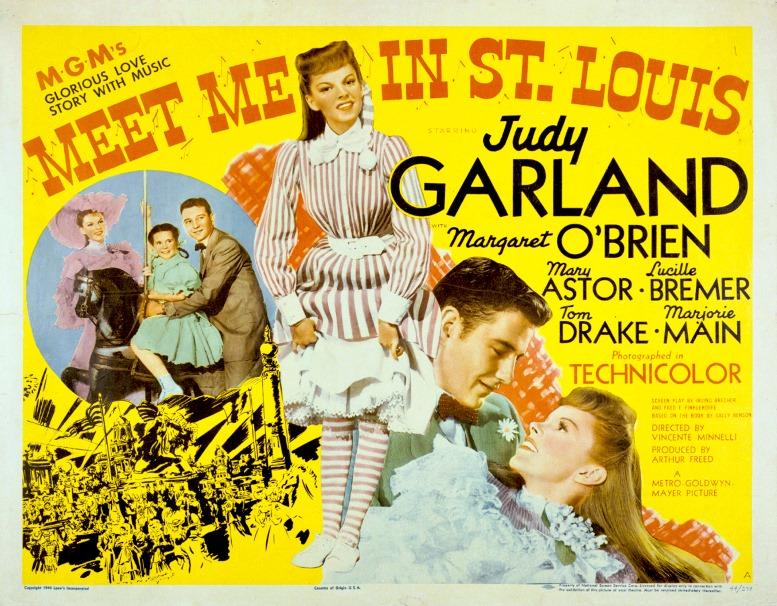 Arch,
finished in 1965.
Arch,
finished in 1965.
I remember seeing its graceful shape far off in the distance when my wife and I drove across America in 1977, and my son remembers seeing it when he did the same drive in 1998. There’s now a vast new visitors center and museum at its base, amidst well-landscaped grounds (they buried a highway that used to run through it), that will tell you everything you’d want to know about the design and construction of this Midwestern wonder of the world.
Although the city has only 320,000 residents, it has the feel of a bigger city as it sprawls along the Mississippi River, married briefly to both the Missouri and the Illinois, crisscrossed by four interstate highways, with 79 designated neighborhoods.
This is the city lovingly exalted by the 1944 movie “Meet Me in St. Louis,” centered around the city’s 1904 Louisiana Purchase Exposition (though filmed on MGM’s back lots), the same year it hosted the Summer Olympics.
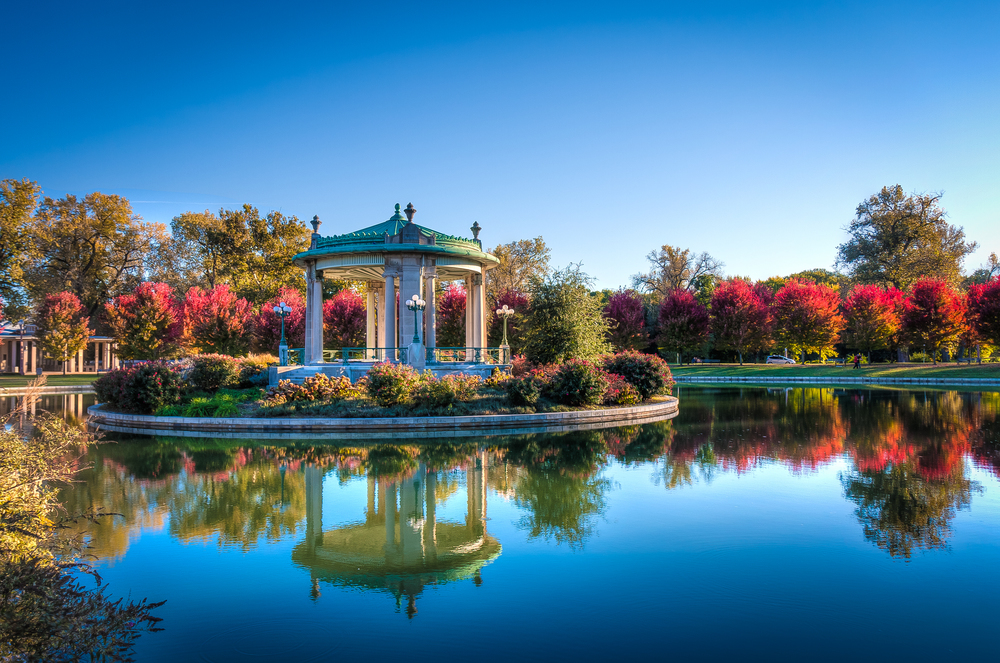 The
city dates back to fur trading days, founded by
the French in 1764, acquired by the United States
in the Louisiana Purchase of 1803. Steamboats
plied its rivers by 1818, and Missouri became a
state three years later.
The
city dates back to fur trading days, founded by
the French in 1764, acquired by the United States
in the Louisiana Purchase of 1803. Steamboats
plied its rivers by 1818, and Missouri became a
state three years later.
Like all expanding Midwest cities, wealth brought
culture, and today St. Louis is a home to some
extraordinary museums and attractions—most of them
open to the public gratis. Some lie within Forest Park (left), site
of both the Exposition and Olympics, which
attracts 12 million visitors each year. It’s much
larger than New York’s Central Park and includes
the Missouri
History Museum and one of America’s
greatest cultural institutions, the St. Louis Art Museum
(right).
On a recent trip there, I was struck not only by
the comprehensive nature of its 34,000 holdings,
from Ancient American art and Art of the 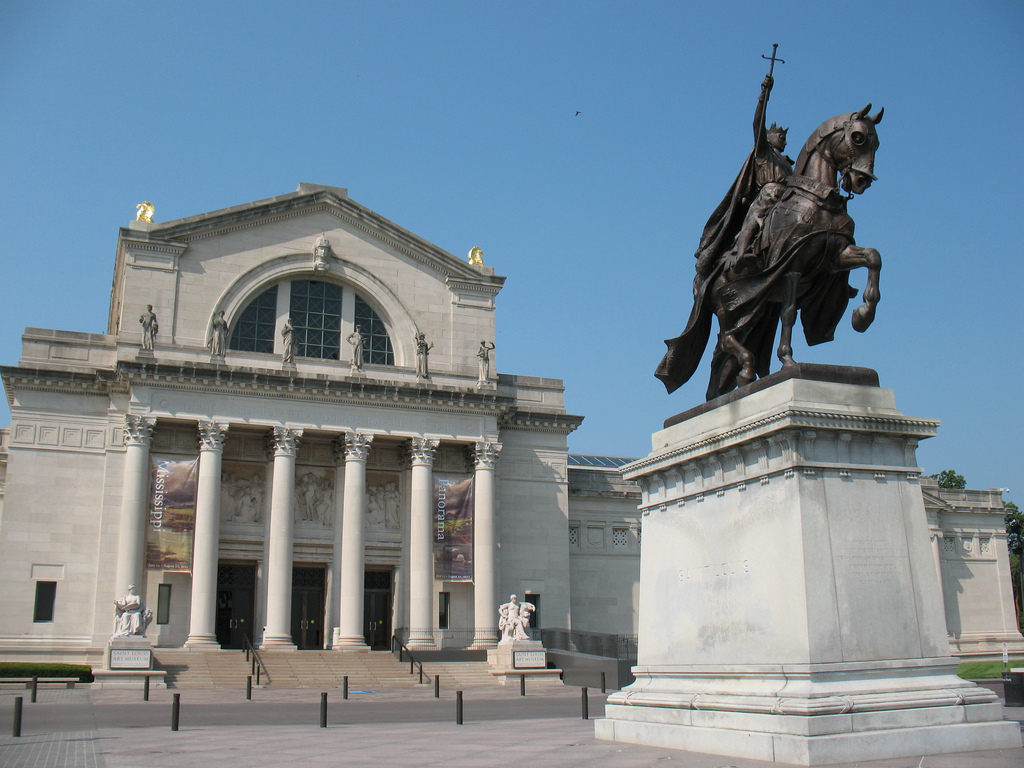 Pacific to Medieval and renaissance
rooms, Islamic exhibitions, stunning Asian
pottery, and modern art (with one of the largest
collections of the German artist Max Beckmann), but with its perfect, soft
lighting in both galleries and open spaces.
Pacific to Medieval and renaissance
rooms, Islamic exhibitions, stunning Asian
pottery, and modern art (with one of the largest
collections of the German artist Max Beckmann), but with its perfect, soft
lighting in both galleries and open spaces.
Elsewhere in St. Louis are the Contemporary Art Museum and the Mildred Lane Kemper Art Museum. The city’s Symphony dates back to 1880, now performing in the gorgeous and opulent Powell Hall.
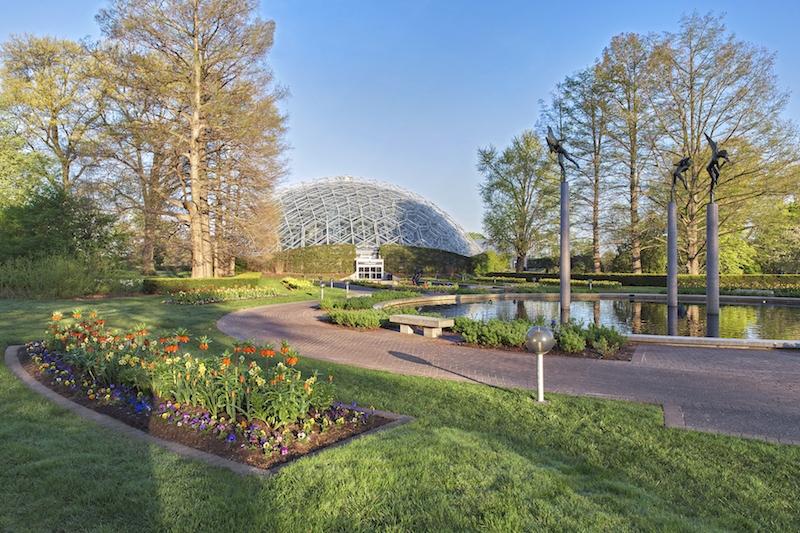 The Missouri Botanical
Garden (left),
spread out over 79 acres, is the
oldest of its kind in the U.S., with an indoor
rainforest, waterfalls, tropical birds, a serene
Japanese garden and children’s educational area,
all connected by an on-and-off tram.
The Missouri Botanical
Garden (left),
spread out over 79 acres, is the
oldest of its kind in the U.S., with an indoor
rainforest, waterfalls, tropical birds, a serene
Japanese garden and children’s educational area,
all connected by an on-and-off tram.
I’ll be writing about the city’s culinary
offerings in upcoming articles, but I can’t fail
to mention that St. Louis is an historic and major
beer producer, with visits to huge breweries like
Anheuser-Busch 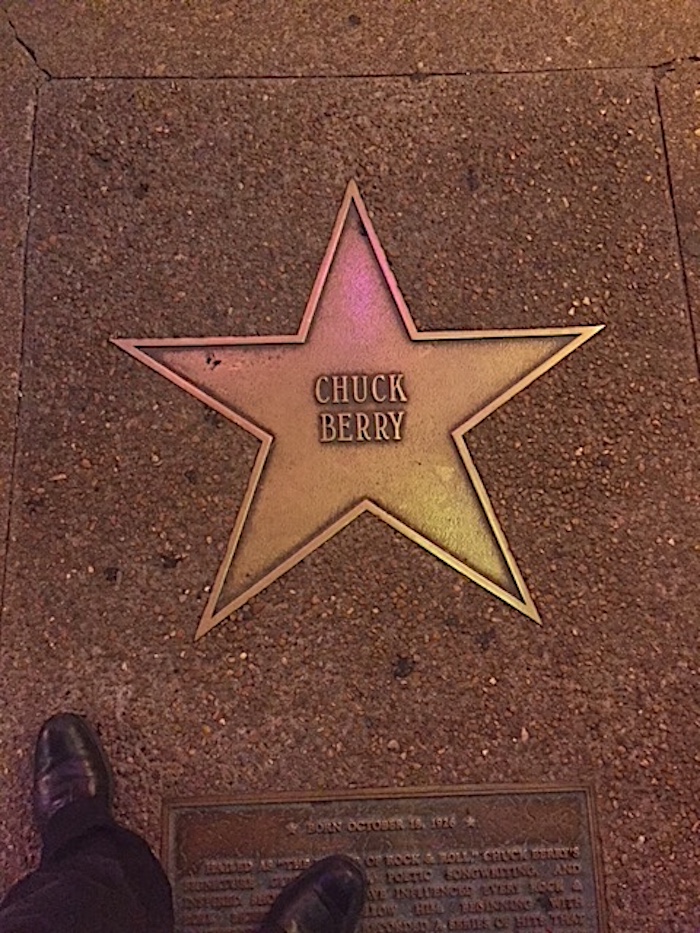 (now owned
by Belgians) requisite, along with brewery tour
companies that visit artisanal and microbreweries
throughout the city.
(now owned
by Belgians) requisite, along with brewery tour
companies that visit artisanal and microbreweries
throughout the city.
One of the most revealing aspects for me while touring the city’s bustling Delmar Loop in the University area were the sidewalks implanted with bronze stars commemorating St. Louis’s native sons and daughters of national and international renown, including actors like Betty Grable and Vincent Price; authors like T. S. Eliot, William Inge, Marianne Moore, Maya Angelou and Howard Nemerov; sports figures like Yogi Berra, Jimmy Connors and Sonny Liston; and a slew of musicians like Josephine Baker, Tina Turner, Albert King, Chuck Berry and Scott Joplin. Probably its best-known citizen was the man who flew the plane named after the city, Charles Lindbergh.
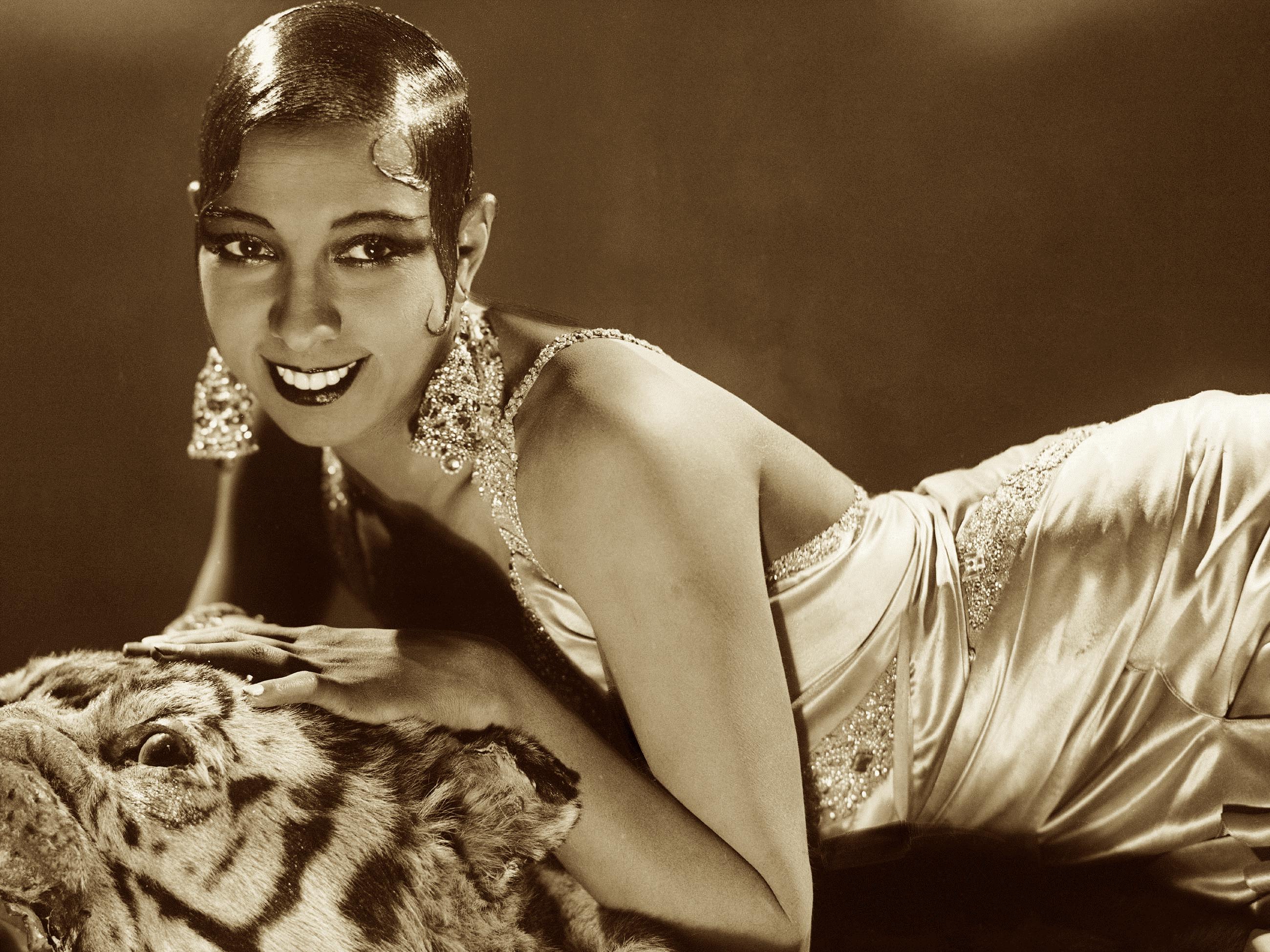 Not all of them loved
their hometown, and many left as soon as they
could. “I ran away from St. Louis,” said Josephine
Baker (left),
“and then I ran away from the United States,
because of that terror of discrimination.”
Not all of them loved
their hometown, and many left as soon as they
could. “I ran away from St. Louis,” said Josephine
Baker (left),
“and then I ran away from the United States,
because of that terror of discrimination.”
After World War II, St. Louis was not without its urban problems. There was much decay surrounding the downtown area, with gray stretches of un-patched roads and trash-strewn vacant lots; today its population is 100,000 people fewer than it was in 1950, when a flight to the suburbs began. Only Detroit and Youngstown, Ohio, have seen such precipitous declines. The city has had to battle its image as having the highest murder rate per capita in the U.S.
But
infusions of Asian immigrants in recent
years—Chinese in the Central West End, Vietnamese
in Dutchtown—and Latinos have enriched the ethnic
base of the city,
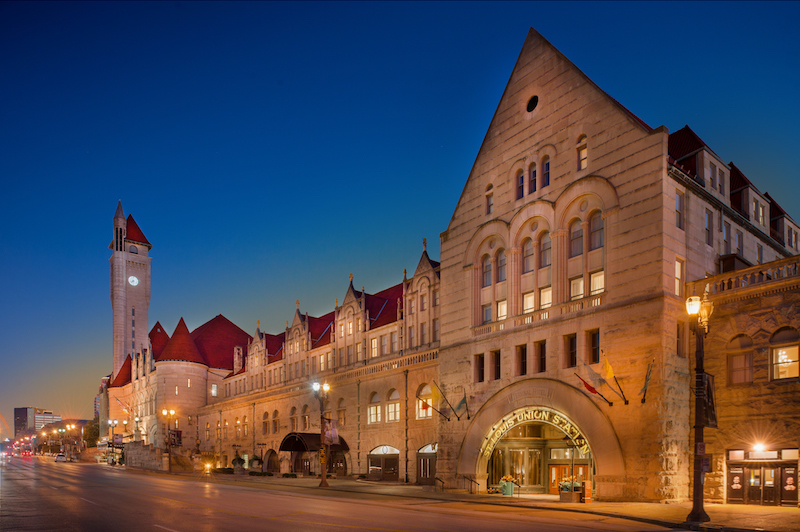 now
almost 50% African-American. A lavish casino
has helped revive downtown, and the city’s sports
teams—the Cardinals and the Blues—do very well;
the city’s major industries are sound, its
colleges and universities well regarded. Ten
Fortune 500 companies reside there. Boeing employs
15,000 at its campus north of the city, and, as in
so many Midwestern cities now, the medical sector
is a leader in technology and employment.
Washington University’s medical school is ranked
one of the top ten in the U.S.
now
almost 50% African-American. A lavish casino
has helped revive downtown, and the city’s sports
teams—the Cardinals and the Blues—do very well;
the city’s major industries are sound, its
colleges and universities well regarded. Ten
Fortune 500 companies reside there. Boeing employs
15,000 at its campus north of the city, and, as in
so many Midwestern cities now, the medical sector
is a leader in technology and employment.
Washington University’s medical school is ranked
one of the top ten in the U.S.
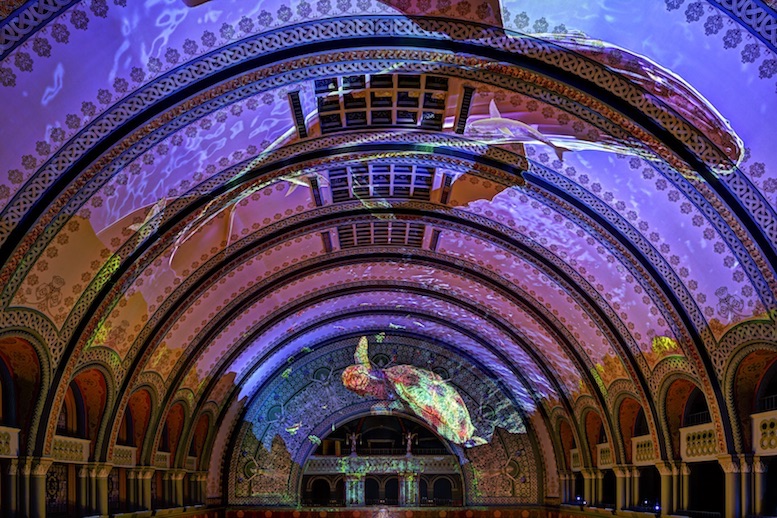 Symptomatic
of both that decline and current rebound is one of
the city’s most extraordinary pieces of reclaimed
architecture, the landmark Union Station,
once the largest and busiest train station in the
world, with 100,000 passengers a day arriving or
departing on 22 train lines, a true crossroads of
America. Opened in 1894, it thrived until airlines
pushed passenger train companies into bankruptcy,
so that by 1978 no trains pulled in or our of this
majestic station. Those that do come through St.
Louis now come through an adjacent ungainly
looking shack.
Symptomatic
of both that decline and current rebound is one of
the city’s most extraordinary pieces of reclaimed
architecture, the landmark Union Station,
once the largest and busiest train station in the
world, with 100,000 passengers a day arriving or
departing on 22 train lines, a true crossroads of
America. Opened in 1894, it thrived until airlines
pushed passenger train companies into bankruptcy,
so that by 1978 no trains pulled in or our of this
majestic station. Those that do come through St.
Louis now come through an adjacent ungainly
looking shack.
Saving the landmark showed the true modern spirit of St. Louis, when a $150 million renovation turned the station into an upscale hotel, now run by Hilton. Several times a day now a spectacular laser light show is splashed across its vast 65-foot-tall Grand Hall and stained glass windows depicting St. Louis as the center of America.
❖❖❖
By John Mariani
485 Seventh Avenue (near 37th Street)
212-268-1888
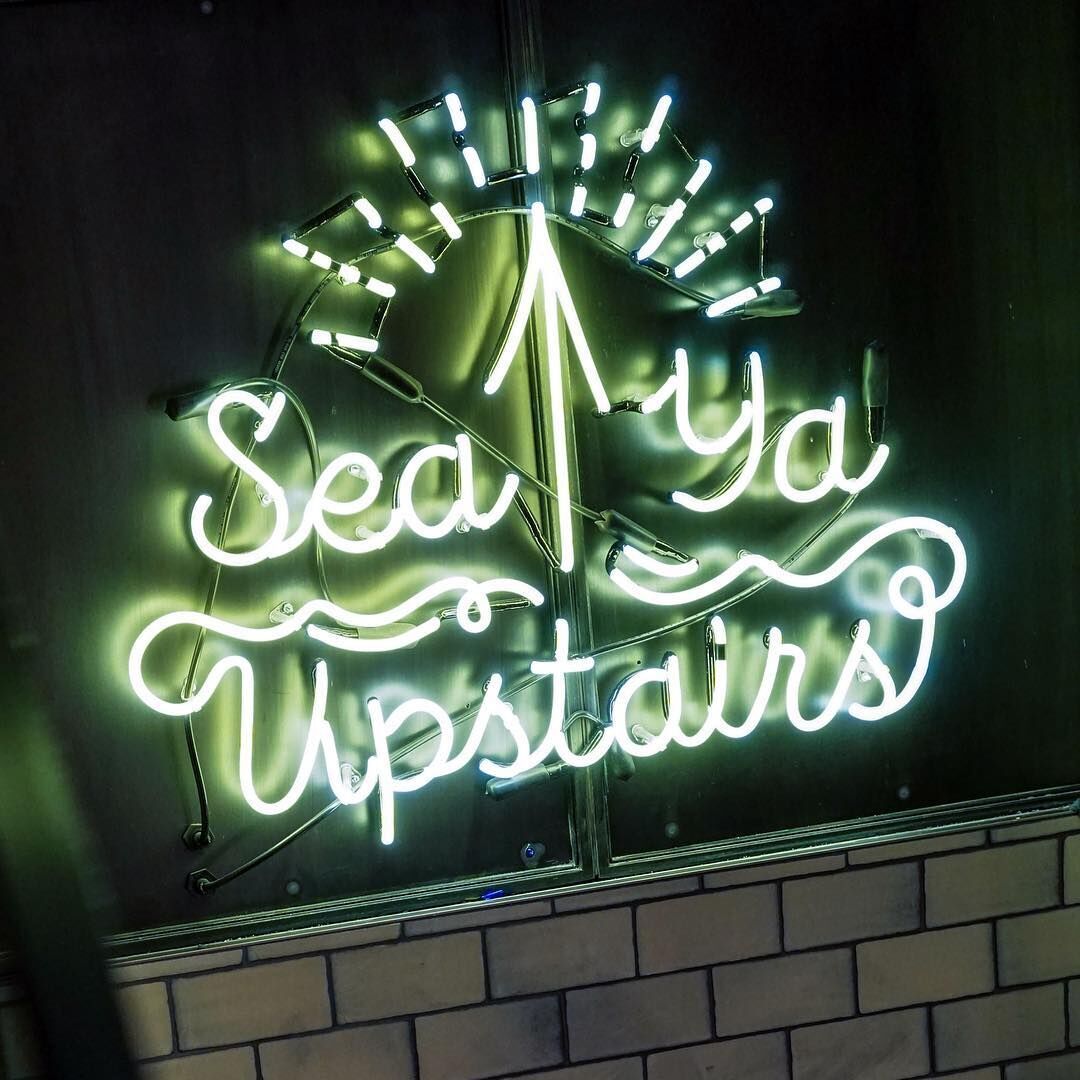
Six
nights a week, the Times Square area is a
mad, deafening rush of New Yorkers,
tourists, cops, food trucks, buses, cars and
taxis.
People disgorge from the restaurants
at six-thirty p.m. to catch a curtain or
head to Madison Square Garden for a Billy
Joel concert.
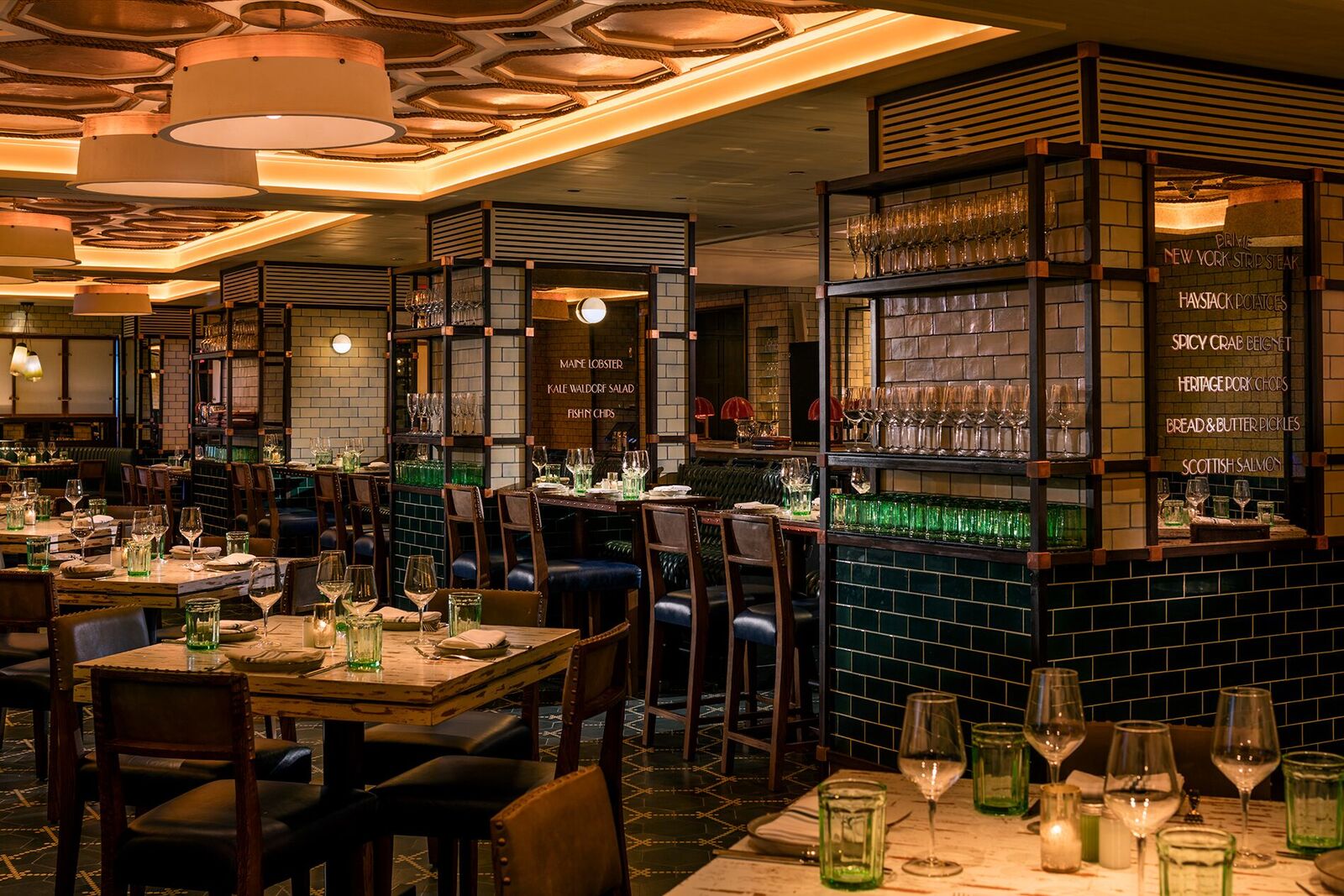 But on Monday
nights, when the theaters are closed, the area
is calmer, people aren’t in such a rush, and
you can really appreciate the extravagance of the
light shows up and down Broadway. So
it was a good night for me and my guests to
try out a year-old restaurant in the Moxy
Hotel, when we didn’t run into the buzz saw of
exiting diners. (Actually there was one table
next to us talking so loud they did sound like
a turbine generator, but fortunately they
bolted to catch a Knicks game at the Garden.)
But on Monday
nights, when the theaters are closed, the area
is calmer, people aren’t in such a rush, and
you can really appreciate the extravagance of the
light shows up and down Broadway. So
it was a good night for me and my guests to
try out a year-old restaurant in the Moxy
Hotel, when we didn’t run into the buzz saw of
exiting diners. (Actually there was one table
next to us talking so loud they did sound like
a turbine generator, but fortunately they
bolted to catch a Knicks game at the Garden.)
So it was easier to
appreciate this handsome, marine-themed
restaurant up a flight of stairs off Seventh
Avenue, with walls of old-fashioned white and
green tiles, cushy banquettes, rough wood
tables, and a ceiling with panels that soak up
noise.
I had not actually
heard of Legasea, and I’m sure the reasons it
had not been much talked about or reviewed by
the media had 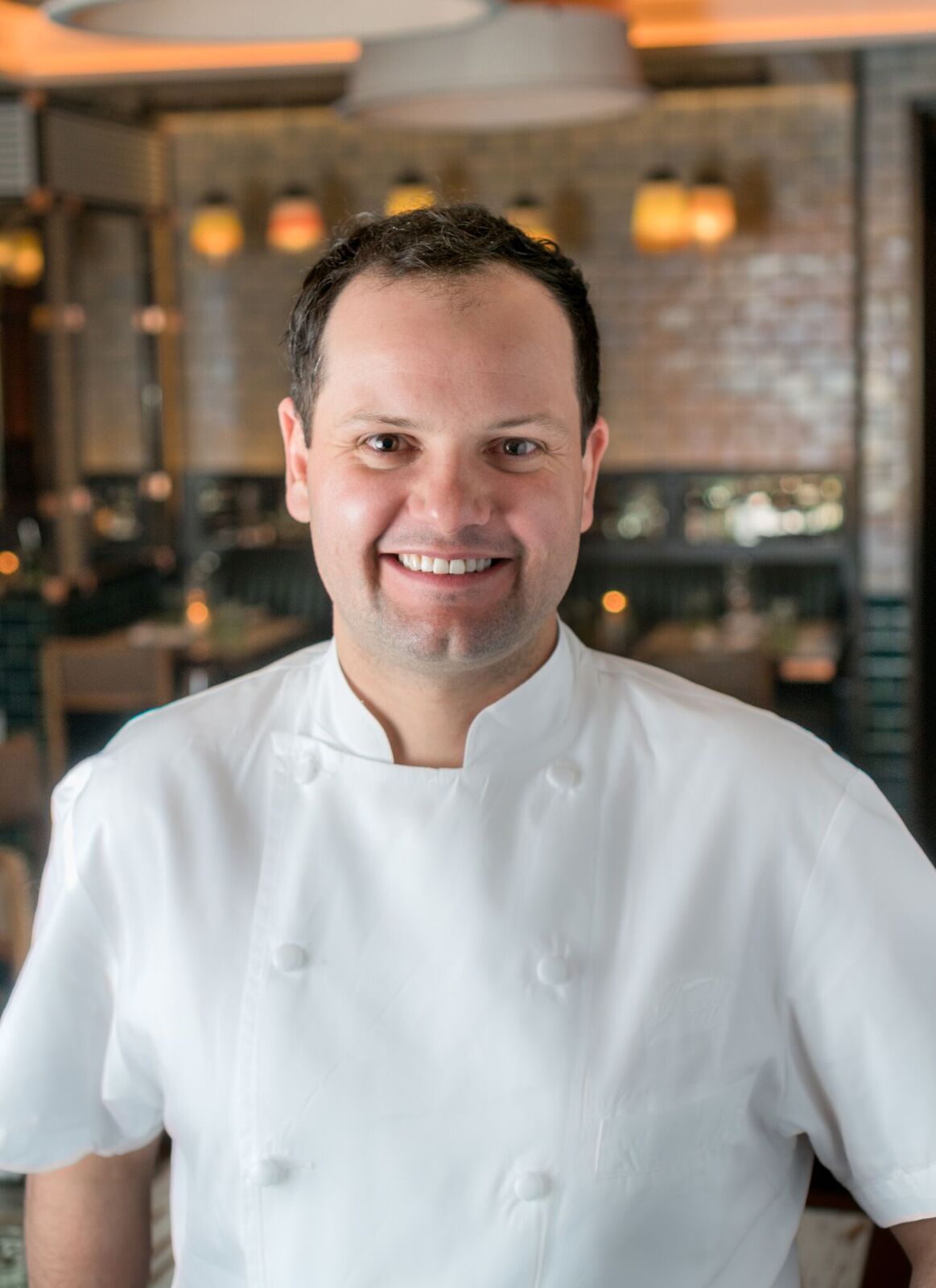 to do with the usual
bias against hotel restaurants, especially one
in the Theater and Garment District, and not
least because it is owned by the international
TAO Group, known more for its ear-splitting
mega-nightclub restaurants than its fine
cuisine.
to do with the usual
bias against hotel restaurants, especially one
in the Theater and Garment District, and not
least because it is owned by the international
TAO Group, known more for its ear-splitting
mega-nightclub restaurants than its fine
cuisine.
But at Legasea, a
smaller venue, they had the good sense to put
a top-notch, very experienced chef in the
kitchen—Jason Hall, who’s worked at an
impressive number of restaurants in and out of
New York, including Craft, Hearth, Gotham Bar
& Grill and Anthos, this last a
revolutionary Greek restaurant I picked as the
best new restaurant of the year when it opened
about ten years ago.
Legasea also enjoys
the careful, cordial professionalism of
general manager Alexandra Lesser, who’s worked
with TAO restaurants in the past and even
opened a restaurant in Dubai. The
waitstaff is equally as personable, though at
slow times in the evening they congregate too
frequently at the bar.
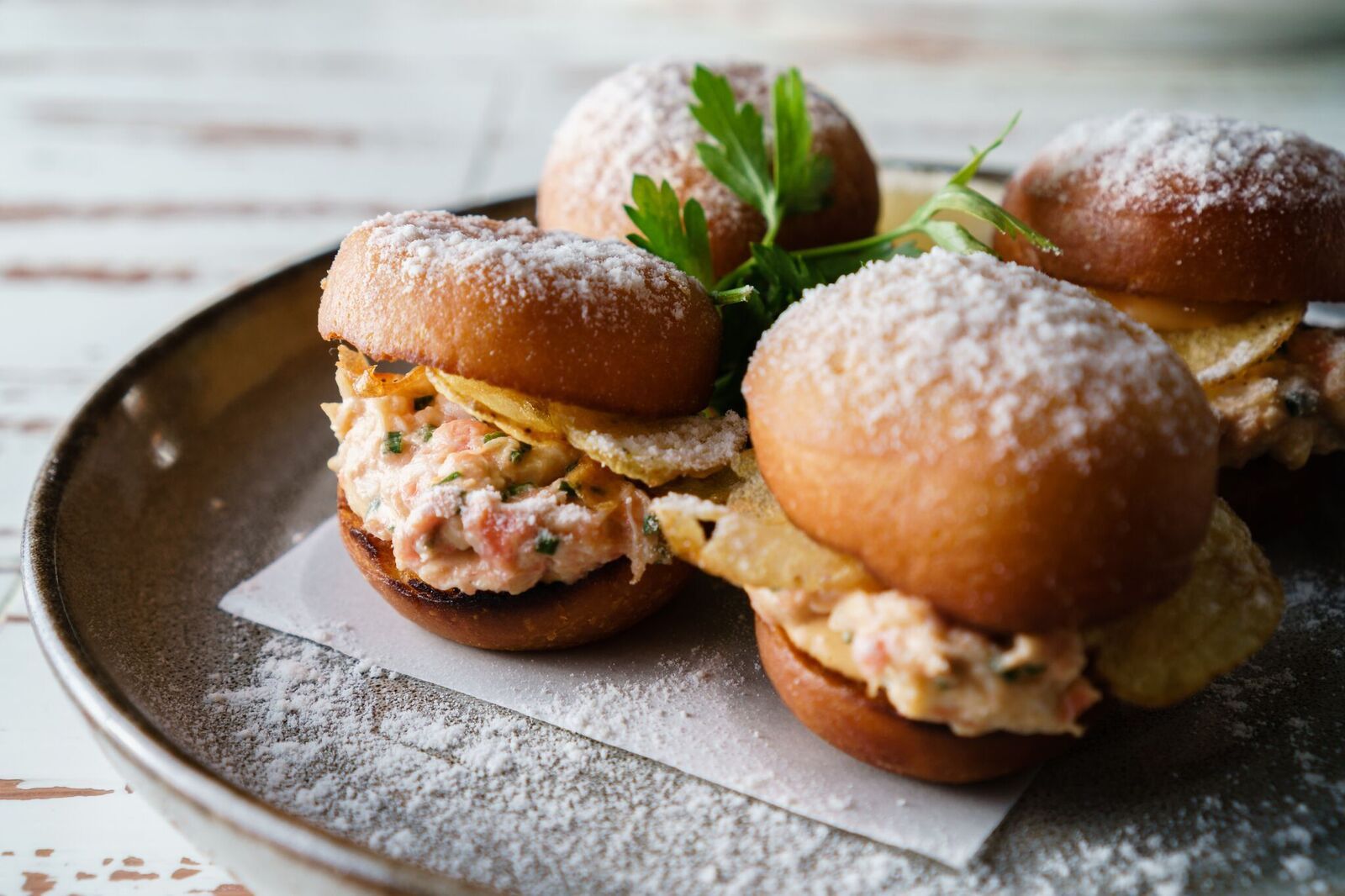 The menu is
deceptively traditional for a seafood house.
There are all the expected items, from a
generously proportioned seafood tower ($75 to
$105) of raw shellfish, lobster, crab, mussels
and shrimp with various sauces to fried
calamari with zucchini and cherry tomatoes
sauce ($17). You can get simply cooked fish
and end off with a slice of cheesecake. But
that is far from all that Hall is producing. He’s
certainly
not alone in pursuing sustainability of his
products, but he is one of the rare chefs who
brings in wild branzino and other species
from the Mediterranean and Montauk. But first
you begin with a pan of hot, buttered salted
yeast rolls and spreads you’d wish more places
served instead of the usual bread basket.
The menu is
deceptively traditional for a seafood house.
There are all the expected items, from a
generously proportioned seafood tower ($75 to
$105) of raw shellfish, lobster, crab, mussels
and shrimp with various sauces to fried
calamari with zucchini and cherry tomatoes
sauce ($17). You can get simply cooked fish
and end off with a slice of cheesecake. But
that is far from all that Hall is producing. He’s
certainly
not alone in pursuing sustainability of his
products, but he is one of the rare chefs who
brings in wild branzino and other species
from the Mediterranean and Montauk. But first
you begin with a pan of hot, buttered salted
yeast rolls and spreads you’d wish more places
served instead of the usual bread basket.
One of Hall’s
signature items this season is acorn squash
that is slow-roasted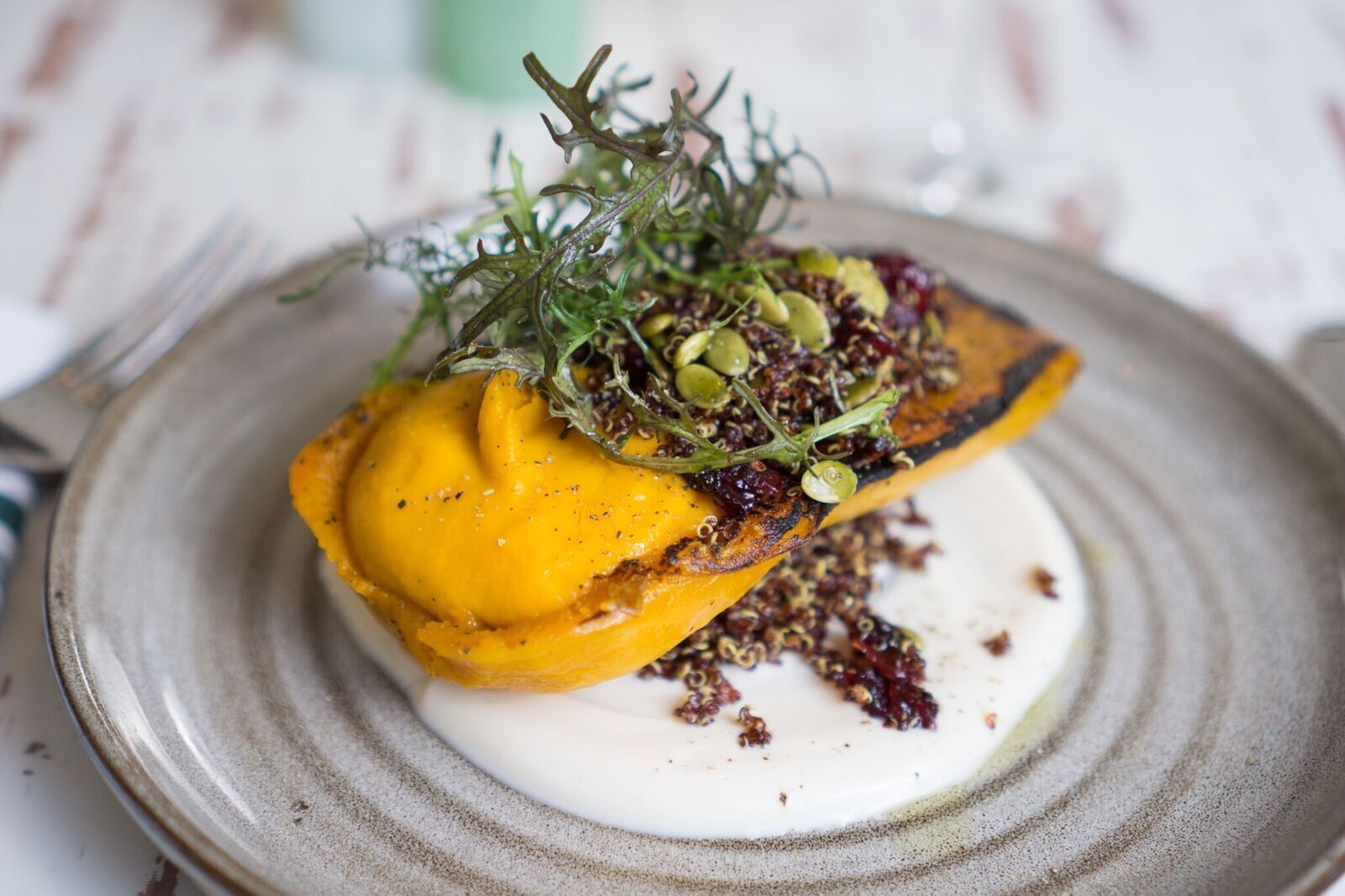 in olive oil and
lemon and served with a cold maple yogurt
($10). Quinoa is crisped in the oven and
sprinkled atop the squash (right),
with pumpkin seeds and tart dried cherries for
garnish. I told you this was not your usual
seafood house.
in olive oil and
lemon and served with a cold maple yogurt
($10). Quinoa is crisped in the oven and
sprinkled atop the squash (right),
with pumpkin seeds and tart dried cherries for
garnish. I told you this was not your usual
seafood house.
Also out of the
ordinary are his creamy, piled-high crab
beignets (above,
left) with chipotle-laced crème
fraȋche and a powder made from Indian butter
($16). The
tuna tartare ($22) comes glistening and sweet,
mixed with avocado, soy ginger vinaigrette and
served with lavash crackers. And
I was really happy with an old-fashioned salad
he calls BLT of cold iceberg lettuce tossed
with bleu cheese and crispy shallots for
crunch ($16), which easily serves two people.
That wild branzino
($39), which comes to the table splayed, is
wonderful, but yellowfin tuna au poivre
($36) lacked flavor, in both the fish itself
and the black pepper. Chatham
cod fish and chips ($29) was perfectly cooked,
so that the batter stayed crisp and the cod
exceptionally moist but not steamy within,
served with good French fries. We
also ordered some German butterball potatoes
with chives and 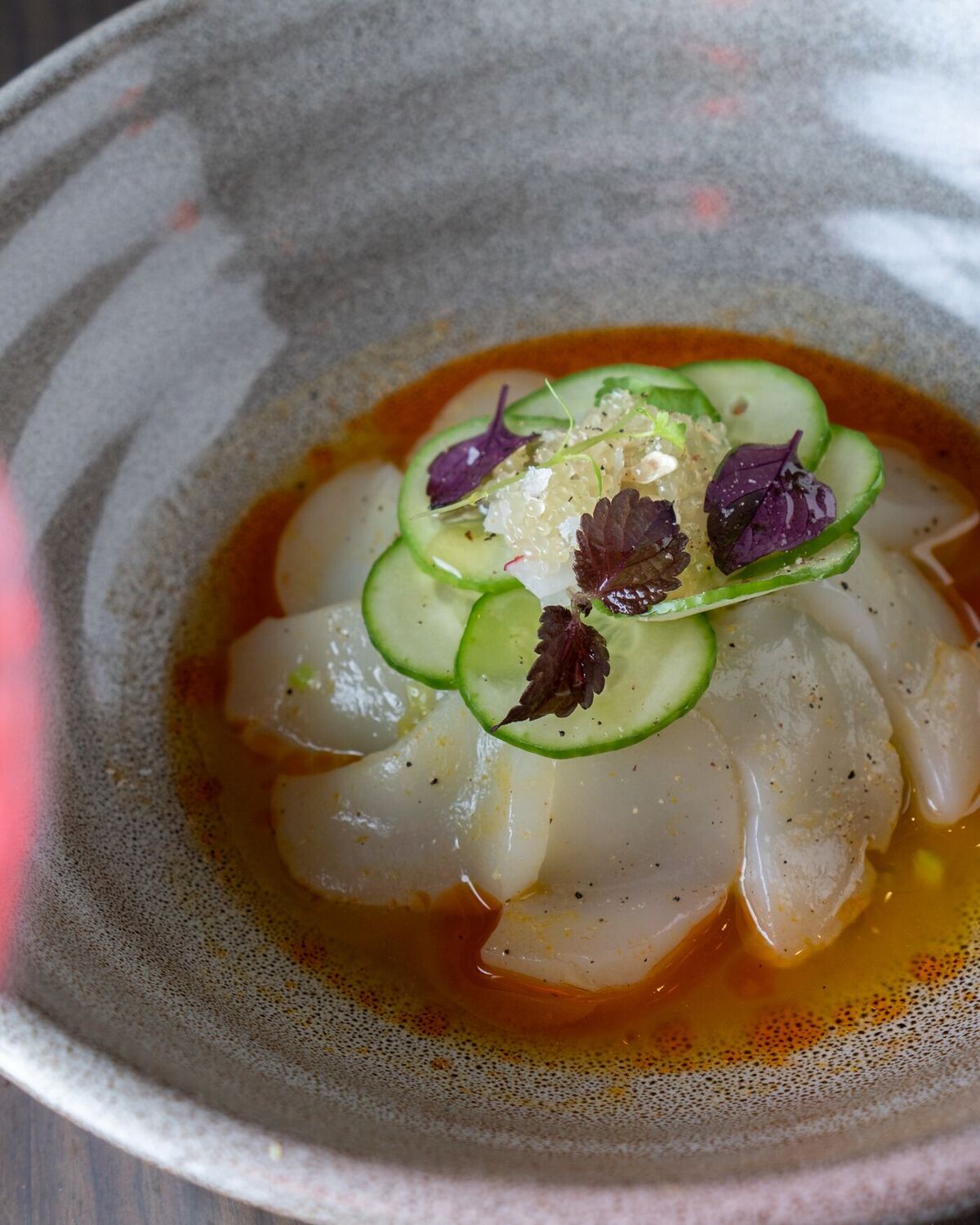 truffle
butter for the table ($12).
truffle
butter for the table ($12).
Hall makes all his
own pastas, and it showed in the fine texture
of black pasta shells in a very savory,
well-seasoned sauce of lobster, shrimp,
scallops and spicy cherry tomatoes. ($27).
We were pretty sated
by this point, but could hardly refuse two
styles of fall dessert: fried apple fritters
that had a delightful sweet-sour balance, and
soft baked donuts kissed with cinnamon sugar. My
wife had to have the recipe for that one.
Those
desserts were gobbled up, but I cannot fail to
mention the assortment of excellent
ice creams and sorbets (three for $15) with
which you can have toppings like Oreo crumbs
and gingersnap cookies.
We were at our
table at Legasea for nearly three hours, not
because there was a lag in service or delivery
of the food but because we just kept enjoying
every morsel of what was placed before us.
More abstemious gourmets might have stopped
after the shellfish tower, but on that lovely
Monday night in New York we were wholly
content to be right where we were in the heart
of the city.
❖❖❖
By John Mariani
 As
the harvests end in northern hemisphere wine
estates, new vintages from prior years come
into the market. Here are some I’m
enjoying at the moment.
As
the harvests end in northern hemisphere wine
estates, new vintages from prior years come
into the market. Here are some I’m
enjoying at the moment.
BARON DE BRANE
2010 ($27)—Very
rich, very supple, very layered, showing its
Margaux appellation beautifully. The blend is
53% Cabernet Sauvignon and 47% Merlot, with no
Cabernet Franc. The vintage was a dry year
with cool summer nights that helped build up
the aroma and phenolics. This is the second
wine of Château Brane-Cantenac, a renowned
second growth, overseen by Henri Lurton, and a
very good price for a Bordeaux of this
quality. It’s ready to drink right now.
CHÂTEAU GRAND
TAYAC 2014 ($33)—I was equally taken
with this Margaux, though perhaps less
multi-dimensional than the Baron de Brane
right now—and it’s young. It was rewarding for
its deep fruit flavors, lush feel on the
palate and long finish. Winemaker Eric
Boissenot, who consults for many of the First
Growth Bordeaux, makes a small number of
bottles he proudly puts his reputation behind.
DRY CREEK THE
MARINER 2014 ($50)—With 69% Cabernet
Sauvignon, 12% Petit Verdot, 9% Merlot, 8%
Malbec and 2% Cabernet Franc, this is a
carefully cultured blend from Sonoma County,
and it has plenty of pleasure in it with soft
fruit and tannins—very much a
fine example of a Meritage wine, which Dry
Creek pioneered back in the 1980s. The name
refers to a poem by Longfellow on the label
entitled “The Building of the Ship”: “In spite
of rock and tempest’s roar,/ In spite of false
lights on the shore,’/ Sail on, nor fear to
breast the sea!” Whatever.
LONG MEADOW RANCH
WINERY ANDERSON VALLEY PINOT NOIR 2015
($40)—Subtlety is a virtue too often lost on
California’s Pinot Noir makers, so I applaud
how Long Meadow Ranch’s owners, Ted, Laddie
and Christopher Hall, who make their wines
right along with olive and fruit orchards as
well as raising cattle and horses, have
produced a wine that is supple, fruit forward
but not massive, neither in its alcohol
(13.5%) nor its tannins. It
tastes of Anderson Valley terroir, and this
autumn I’ll be drinking it with roast duck and
cherries or any mushroom-hearty dish.
GEORGÓS “FARMER”
SIREN’S LURE 2014 ($31)—A Cabernet
Sauvignon, Merlot, Cabernet Franc and Malbec
blend, this wine shows how far Greek reds have
come just in the past five years. The siren in
the name references Corfu and its alluring sea
serpents who seduced Ulysses. All grapes are
100% non-GMO sustainably grown. It’s a nicely
robust red at 14.4% alcohol and is perfect
with roast lamb or lamb chops.
PLANTATION XAYMACA SPECIAL DRY ($24.99)—The question with rum is:
Is it too good to be used in a
cocktail? With this new import from
 Jamaica,
the answer is that
Jamaica,
the answer is that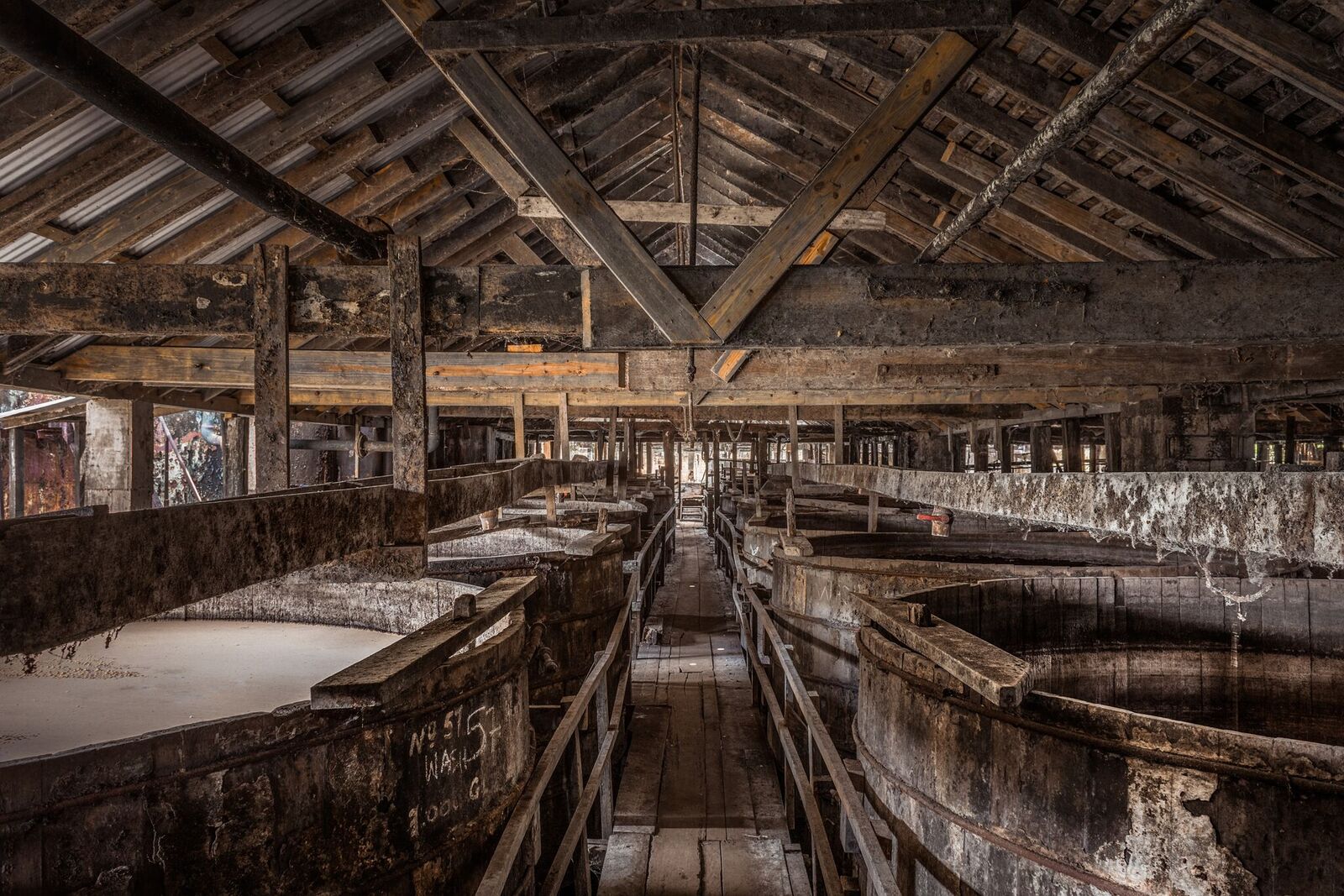 it is a very good, medium-bodied
rum that blends impeccably into a Daiquiri
or rum punch—though lost in a piña
colada—while it’s an easy rum to sip on
its own, before or after dinner. At 86 proof,
it’s not too weighty, and master blender
Alexandre Gabriel sought to emphasize the
fruit and spice flavors with “animal
intensity,” achieved by aging to a medium
amber color. Maison Ferrand, best known for its
Pierre Ferrand Cognac, owns two historic pot
still distilleries at Long Pond (right)
and Clarendon, known for their high
esters.
it is a very good, medium-bodied
rum that blends impeccably into a Daiquiri
or rum punch—though lost in a piña
colada—while it’s an easy rum to sip on
its own, before or after dinner. At 86 proof,
it’s not too weighty, and master blender
Alexandre Gabriel sought to emphasize the
fruit and spice flavors with “animal
intensity,” achieved by aging to a medium
amber color. Maison Ferrand, best known for its
Pierre Ferrand Cognac, owns two historic pot
still distilleries at Long Pond (right)
and Clarendon, known for their high
esters.
❖❖❖
FOOD
WRITING 101: TRY NOT TO
SOUND LIKE AN ABSOLUTE TWIT
"The dishes are intellectually
engaging (yet still delicious) meditations on
flavor and technique. Occasionally, absentee
service interrupts the reverie. Just think of it
as an otherwise beautiful painting diminished by a
few missing brushstrokes.”—"The Best New
Restaurants of 2018: Marisol," Chicago
Magazine (3/18).

WATER STILL SEEMS TO BE OKAY, UNLESS AN ANIMAL PISSED IN IT
According
to Sandi Toksvig, co-host of “The
Great British Bake Off,”
almonds, avocado, kiwi, butternut squash, and melon
are not vegan. “It's the same
reason as honey,” she explained. “They can't exist
without bees, and bees are used in, let's call it an
'unnatural way.' Because they are so difficult to
cultivate naturally, all of these crops rely on bees
which are placed on the back of trucks and taken
very long distances across the country. It's
migratory beekeeping and it's unnatural use of
animals and there are lots of foods that fall foul
of this.”Toksvig went on the say that other fruits
and vegetables such as broccoli, cherries,
cucumbers, and even lettuce are
“actually not strictly vegan.”
Wine
Column Sponsored by Banfi Vintners
SANGIOVESE
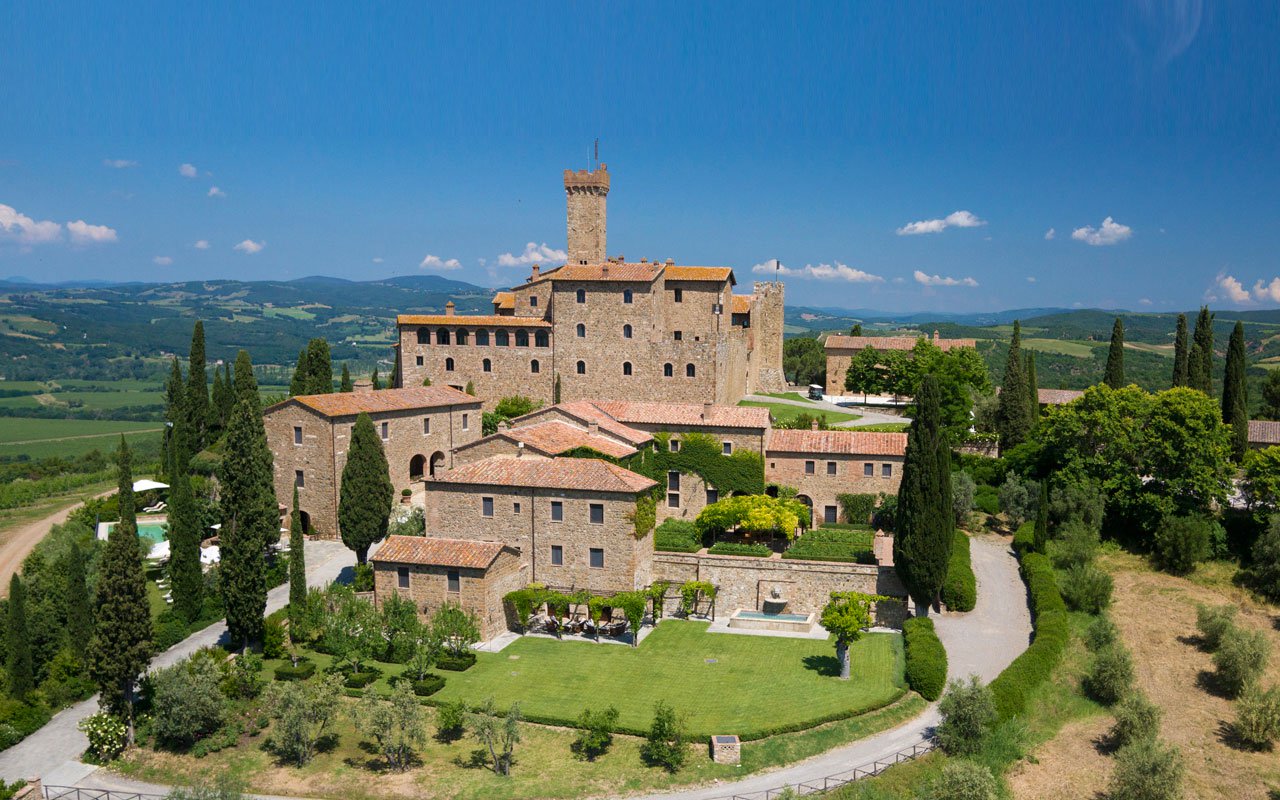 Wine is a joy year-round but
in cooler weather one
grape varietal has really taken center stage in
my daily activities – that most Italian of
grapes, Sangiovese, and its ultimate expression
– Brunello di Montalcino.
Wine is a joy year-round but
in cooler weather one
grape varietal has really taken center stage in
my daily activities – that most Italian of
grapes, Sangiovese, and its ultimate expression
– Brunello di Montalcino.
From mid-September through mid-October,
the Sangiovese grown for our various styles of red
wines are be harvested, culminating with the top
selection for Brunello di Montalcino.
Second, cooler weather here means
it is time to start enjoying more red wines and
especially Sangiovese based wines. That
includes Banfi’s cru of Brunello, Poggio alle Mura,
literally the cream of the crop of our Sangiovese
vineyards. Alongside our Poggio alle Mura Brunello di
Montalcino, this year we introduced two more wines
from the cru Poggio alle Mura – a Rosso di Montalcino
and a Riserva of Brunello. Rosso is sort of like the
younger brother of Brunello, also made from 100%
Sangiovese grapes but usually a selection from younger
vines and the wine is aged only two years compared to
the four required for Brunello. The
Riserva, on the other hand, is an even more selective
harvest of Sangiovese, and ages for an additional year
before release.
What is so special about this cru
Poggio alle Mura?
Well, it is the result our over 30 years of
ongoing research at my family’s vineyard estate,
Castello Banfi.
When we first began planting our vines there in
the late 1970s studies from the University of Bordeaux
indicated which strains of many varietals we should
plant, based on the soil type and microclimate of each
vineyard. But
when it came to the region’s native Sangiovese, there
was only local lore, no scientific research. So we took
it upon ourselves to figure out this vine, and set off
on three decades of incredibly detailed research.
We started
with 600 apparent variations on Sangiovese, because it
is so susceptible to variations in weather and soil,
and narrowed that down to 160 truly genetically
different clones.
We planted a vineyard with two rows of each
type, made wine from each of them, and charted the
differences – remember, you only get one chance a year
to make wine, so this took time.
It took about ten years to get some
concrete results, though we continue to experiment
today and always will – you never stop learning in
science and nature!
Once we determined which were the best,
complementary clones that could be planted together to
make the best Brunello, we chose to plant them in what
we determined to be the optimal vineyard sites. Coincidentally,
the best soils and climate conditions are in the
slopes surrounding the medieval fortress today known
as Castello Banfi, known since Etruscan times as
Poggio alle Mura – the walled hilltop. Hence the
name of our most special “cru” of Brunello,
representing a synthesis between tradition and
innovation.
Though the focus of this study was
our Brunello, all of our Sangiovese-based wines,
including the super Tuscans SummuS, Cum Laude, and
Centine, benefitted from this work. And that’s
the third reason for celebrating Sangiovese this
month, for the range of wonderful reds that usher us
into autumn! One
wine in particular was inspired by our research – the
BelnerO, a Sangiovese dominant blend with what I like
to call a kiss of Cabernet and a whisper of Merlot. We grow the
grapes a little differently for BelnerO than for
Brunello, make the wine with less oak aging and
released it earlier from the winery, providing a
counterpoint to Brunello and a lovely terroir-driven
wine in its own right.
If you
know Italians, you know that by nature we are
multi-faceted, varying in mood, and always passionate. As a
nation, we span from the hot sunny beaches of Sicily
near the African coast to the rugged mountains and
Alpine ski slopes of Trentino-Alto Adige in the north. Sangiovese
is grown in almost all of Italy’s regions and reflects
the unique nature of each; it is most famous
(rightfully so) in Tuscany, yet even there it reflects
the nuances of each hilltop, valley and subzone. It has
something a little different to say in Brunello than
Chianti, Morellino than Vino Nobile di Montepulciano,
Rosso di Montalcino than Super Tuscan blends.
Here is a smattering of
Sangiovese-based wines that you may wish to get to
know better, reflecting a spectrum that appeals to
every occasion, every taste, and every budget. We can
assure you that the conversation will never become
boring. 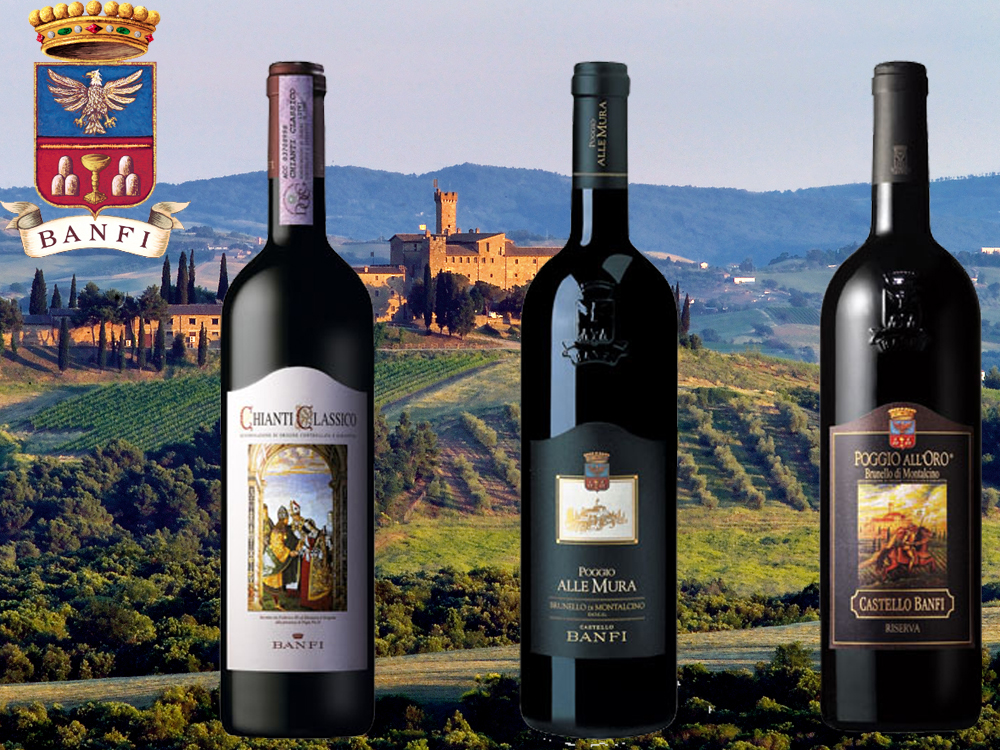
Recommendations for Celebrating
Sangiovese
BelnerO Proprietor’s Reserve Sangiovese
– A refined
cuvée of noble red grapes perfected by our pioneering
clonal research. This dark beauty, BelnerO, is
produced at our innovative winery, chosen 11
consecutive years as Italy’s Premier Vineyard Estate.
Fermented in our patented temperature controlled
French oak and aged approximately 2 additional years.
Unfiltered, and Nitrogen bottled to minimize sulfites.
Castello Banfi Brunello di Montalcino –
Rich, round, velvety and intensely
aromatic, with flavor hints of licorice, cherry, and
spices. Brunello di Montalcino possesses an intense
ruby-red color, and a depth, complexity and opulence
that is softened by an elegant, lingering aftertaste.
Unfiltered after 1998 vintage.
Castello Banfi Rosso di Montalcino – Brunello's "younger brother," produced
from select Sangiovese grapes and aged in barrique for
10 to 12 months. Deep ruby-red, elegant, vibrant,
well-balanced and stylish with a dry velvety
finish.
Poggio all’Oro Brunello di Montalcino
Riserva – A single vineyard selection of our most
historically outstanding Sangiovese, aged five years
before release, the additional year more than that
required of Brunello including 6 months in barrel and
6 months more in bottle to grant its “Riserva”
designation. Incredible
elegance and harmony. Intense with lots of fruit and
subtle wood influence. Round, complete, well balanced
with hints of chocolate and berries. Unfiltered after
1998.
Poggio alle Mura – The first tangible result of years of
intensive clonal research on Montalcino’s native
Sangiovese grape.
Estate bottled from the splendidly sun drenched
vineyards surrounding the medieval Castello from which
it takes its name.
The Brunello
di Montalcino is seductive, silky and smoky. Deep ruby
in color with an expressive bouquet of violets, fruits
and berries as well as cigar box, cedar and exotic
spices. The Rosso
di Montalcino is also intense ruby red. The bouquet
is fresh and fruity with typical varietal notes of
cherry and blackberry, enriched by more complex hints
of licorice, tobacco and hazelnut. It is full
bodied, yet with a soft structure, and a surprisingly
long finish. The Poggio alle Mura Brunello di Montalcino
Riserva is deep ruby red with garnet
reflections and a rich, ample bouquet that hints of
prune jam, coffee, cacao and a light balsamic note. It is full
and powerful, with ripe and gentle tannins that make
it velvety and harmonious; this wine is supported by a
pleasing minerality that to me speaks soundly of that
special hillside in southern Montalcino.
SummuS – A wine of towering elegance, SummuS is an
extraordinary blend of Sangiovese which contributes
body; Cabernet Sauvignon for fruit and structure; and
Syrah for elegance, character and a fruity bouquet. An elegant,
complex and harmonious red wine.
Cum Laude – A complex and elegant red which graduated
“With Honors,” characterized by aromas of juicy
berries and fresh spices.
Centine – A Cuvee that is more than half
Sangiovese, the balanced consisting of equal parts of
Cabernet Sauvignon and Merlot. Vinified in
a firm, round style that easily accompanies a wide
range of dishes, this is a smooth and fragrantly
satisfying wine with international character, and a
perennial favorite at my own dinner table.
Banfi Chianti Superiore – The “Superiore” designation signifies
stricter government regulations regarding production
and aging requirements, as compared to regular
Chianti. An
intense ruby red wine with fruit forward aromas and
floral notes. This
is a round wine with well-balanced acidity and fruit.
Banfi Chianti Classico – An enduring classic: alluring
bouquet of black fruit and violets; rich flavors of
cherry and leather; supple tannins and good acidity
for dining.
Banfi Chianti Classico Riserva – Produced from select grapes grown in the
"Classico" region of Chianti, this dry, fruity and
well-balanced red has a full bouquet reminiscent of
violets.
Fonte alla Selva Chianti Classico – This is our newest entry into the Chianti
arena, coming from a 99 acre estate in Castellina, the
heart of the Chianti Classico region. The wine is
a captivating mauve red that smells of cherry, plum
and blackberry with hints of spice. It is
round, full and balanced with very good
acidity.
Col di Sasso – Sangiovese and Cabernet Sauvignon. Luscious,
complex and soft with persistent notes of fruit and
great Italian style structure.
Any of John Mariani's books below may be ordered from amazon.com.
 The Hound in Heaven
(21st Century Lion Books) is a novella, and
for anyone who loves dogs, Christmas, romance,
inspiration, even the supernatural, I hope you'll find
this to be a treasured favorite. The story
concerns how, after a New England teacher, his wife and
their two daughters adopt a stray puppy found in their
barn in northern Maine, their lives seem full of promise.
But when tragedy strikes, their wonderful dog Lazarus and
the spirit of Christmas are the only things that may bring
his master back from the edge of despair.
The Hound in Heaven
(21st Century Lion Books) is a novella, and
for anyone who loves dogs, Christmas, romance,
inspiration, even the supernatural, I hope you'll find
this to be a treasured favorite. The story
concerns how, after a New England teacher, his wife and
their two daughters adopt a stray puppy found in their
barn in northern Maine, their lives seem full of promise.
But when tragedy strikes, their wonderful dog Lazarus and
the spirit of Christmas are the only things that may bring
his master back from the edge of despair. WATCH THE VIDEO!
“What a huge surprise turn this story took! I was completely stunned! I truly enjoyed this book and its message.” – Actress Ali MacGraw
“He had me at Page One. The amount of heart, human insight, soul searching, and deft literary strength that John Mariani pours into this airtight novella is vertigo-inducing. Perhaps ‘wow’ would be the best comment.” – James Dalessandro, author of Bohemian Heart and 1906.
“John Mariani’s Hound in Heaven starts with a well-painted portrayal of an American family, along with the requisite dog. A surprise event flips the action of the novel and captures us for a voyage leading to a hopeful and heart-warming message. A page turning, one sitting read, it’s the perfect antidote for the winter and promotion of holiday celebration.” – Ann Pearlman, author of The Christmas Cookie Club and A Gift for my Sister.
“John Mariani’s concise, achingly beautiful novella pulls a literary rabbit out of a hat – a mash-up of the cosmic and the intimate, the tragic and the heart-warming – a Christmas tale for all ages, and all faiths. Read it to your children, read it to yourself… but read it. Early and often. Highly recommended.” – Jay Bonansinga, New York Times bestselling author of Pinkerton’s War, The Sinking of The Eastland, and The Walking Dead: The Road To Woodbury.
“Amazing things happen when you open your heart to an animal. The Hound in Heaven delivers a powerful story of healing that is forged in the spiritual relationship between a man and his best friend. The book brings a message of hope that can enrich our images of family, love, and loss.” – Dr. Barbara Royal, author of The Royal Treatment.
 |
The Encyclopedia of American Food and Drink by John F. Mariani (Bloomsbury USA, $35) Modesty forbids me to praise my own new book, but let me proudly say that it is an extensive revision of the 4th edition that appeared more than a decade ago, before locavores, molecular cuisine, modernist cuisine, the Food Network and so much more, now included. Word origins have been completely updated, as have per capita consumption and production stats. Most important, for the first time since publication in the 1980s, the book includes more than 100 biographies of Americans who have changed the way we cook, eat and drink -- from Fannie Farmer and Julia Child to Robert Mondavi and Thomas Keller. "This book is amazing! It has entries for everything from `abalone' to `zwieback,' plus more than 500 recipes for classic American dishes and drinks."--Devra First, The Boston Globe. "Much needed in any kitchen library."--Bon Appetit. |
"Eating Italian will never be the same after reading John Mariani's entertaining and savory gastronomical history of the cuisine of Italy and how it won over appetites worldwide. . . . This book is such a tasteful narrative that it will literally make you hungry for Italian food and arouse your appetite for gastronomical history."--Don Oldenburg, USA Today. "Italian
restaurants--some good, some glitzy--far
outnumber their French rivals. Many of
these establishments are zestfully described
in How Italian Food Conquered the World, an
entertaining and fact-filled chronicle by
food-and-wine correspondent John F.
Mariani."--Aram Bakshian Jr., Wall Street
Journal.
"Equal parts
history, sociology, gastronomy, and just
plain fun, How Italian Food Conquered the
World tells the captivating and delicious
story of the (let's face it) everybody's
favorite cuisine with clarity, verve and
more than one surprise."--Colman Andrews,
editorial director of The Daily
Meal.com. "A fantastic and fascinating
read, covering everything from the influence
of Venice's spice trade to the impact of
Italian immigrants in America and the
evolution of alta cucina. This book will
serve as a terrific resource to anyone
interested in the real story of Italian
food."--Mary Ann Esposito, host of PBS-TV's
Ciao
Italia. "John Mariani has written the
definitive history of how Italians won their
way into our hearts, minds, and
stomachs. It's a story of pleasure over
pomp and taste over technique."--Danny Meyer,
owner of NYC restaurants Union Square
Cafe, The Modern, and Maialino.
|
 |
 |
 |
 |
 |
 |
 |
 |
 Everett Potter's Travel Report:
Everett Potter's Travel Report: 
 Eating Las Vegas
JOHN CURTAS has been covering the Las Vegas
food and restaurant scene since 1995. He is
the co-author of EATING LAS VEGAS – The 50
Essential Restaurants (as well as
the author of the Eating Las Vegas web site: www.eatinglasvegas.
He can also be seen every Friday morning as
the “resident foodie” for Wake Up With the
Wagners on KSNV TV (NBC) Channel 3 in
Las Vegas.
Eating Las Vegas
JOHN CURTAS has been covering the Las Vegas
food and restaurant scene since 1995. He is
the co-author of EATING LAS VEGAS – The 50
Essential Restaurants (as well as
the author of the Eating Las Vegas web site: www.eatinglasvegas.
He can also be seen every Friday morning as
the “resident foodie” for Wake Up With the
Wagners on KSNV TV (NBC) Channel 3 in
Las Vegas.
MARIANI'S VIRTUAL GOURMET
NEWSLETTER is published weekly. Publisher: John Mariani. Editor: Walter Bagley. Contributing Writers: Christopher Mariani,
Robert Mariani, Misha Mariani, John A. Curtas, Gerry Dawes, Geoff Kalish,
and Brian Freedman. Contributing
Photographer: Galina Dargery. Technical
Advisor: Gerry
McLoughlin.
If you wish to subscribe to this
newsletter, please click here: http://www.johnmariani.com/subscribe/index.html
© copyright John Mariani 2017

